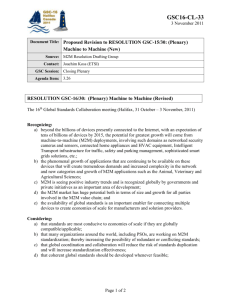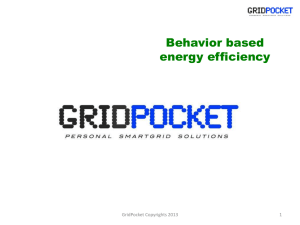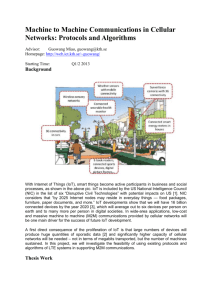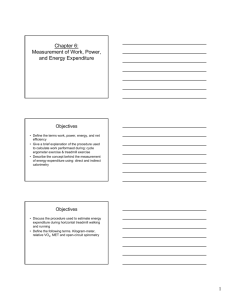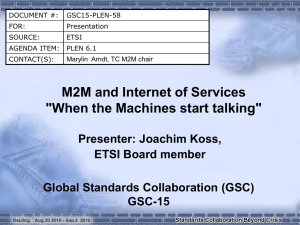Measurement of Work, Power and Energy
advertisement
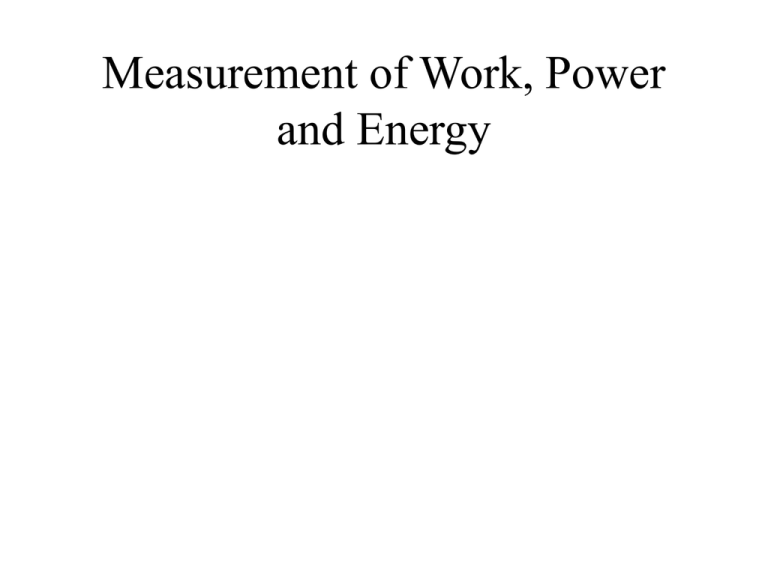
Measurement of Work, Power and Energy Definitions • Force = mass x acceleration • Work = force x distance – units - kpm, kgm, kcal, J, ft-lbs • Power = work / time – units - W, hp, kpm/min Work and Power Calculations • 5-kg weight (11 lbs) lifted 2 m vertical distance – W= 5 kp x 2 m = 10 kpm (kp=kilopon unit of force, same as a kilogram; but kilogram is the force gravity exerts on an object) • Cyclist does 2000 kpm of work in 60 seconds • P=2000 kpm/60s = 33.3 kpm/s Modes of exercise testing • • • • Ergometry/ergometer Ergo = work Ergometry is the measurement of work Ergometer is a device used to measure work Bench step • 70 kg subject steps up 0.5 m bench at 30 steps / min for 10 min – W = 70 kg x 150 m = 10,500 kpm Cycle ergometer • 1-min exercise @ 50 rpm (1 rev = 6 m) with 1 – kg resistance: – W = 300m x 1 kg = 300 kpm Determination of percent grade Treadmill • *vertical displacement = % grade x distance • 70 kg subject running for 10 min at 200 m/min up a 7.5 % grade – W = 70 kp x 15 m (= 1050 kpm) Direct calorimetry Direct Calorimetry • Measurement of heat production as estimate of metabolic expenditure • Food + O2 ATP + Heat Heat cell work Measurement of heat production tells us the amount of metabolic work that has been performed Open circuit spirometry/indirect calorimetry Indirect Calorimetry • Measurement of Oxygen consumption as estimate of metabolic rate • Food + O2 Heat + CO2 + H2O • By determining O2 consumed, can estimate amount of metabolic work performed Estimation of Energy Expenditure • Subject runs 1 mile and consumes 20 l of O2. – Estimated expenditure = 20 l O2 x 5 kcal/l O2= 100 kcal Relationship between speed and VO2 costlinear for walking and running Estimation of Energy Expenditure • Energy cost (O2 consumed) is linear in relation to speed while walking or running • At rest, O2 cost expressed as 1 MET • 1 MET = 3.5 ml/kg/min % Net efficiency % net = efficiency work output energy expended above rest X 100 •Net efficiency of cycling ~ 15-25 % (20 %) Efficiency as Predictor of Performance • Compare runners on horizontal treadmill • The runner who consumes less oxygen at given speed is more efficient • If runners have comparable VO2 max, the more efficient will be more successful • Efficiency can make up for lower VO2 max – Efficiency can make up for poor genetics Change in net efficiency during arm crank ergo vs work rate Relationship between energy expenditure and work rate Muscle Fiber Type and Efficiency • Muscles with high percentage of Type I fibers (slow twitch) are more efficient than muscles with high percentage of Type Iib (fast twitch) So…. • Athletes with higher percentage of Type I (slow twitch) fibers will be more efficient than athletes with higher percentage of Type II b (fast twitch) And…. • Athletes with high percentage of Type I excell at endurance versus athletes with high percentage of Type IIb





